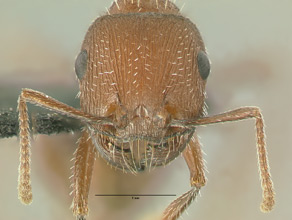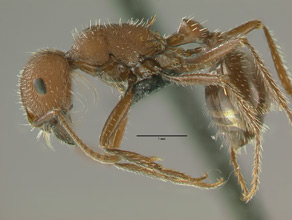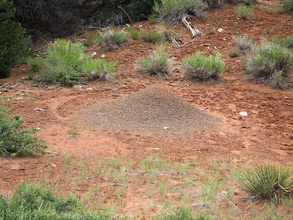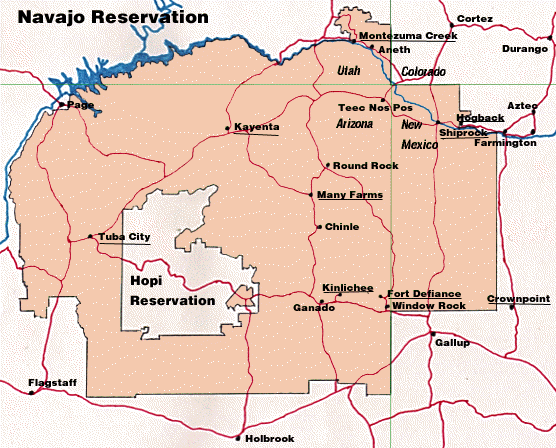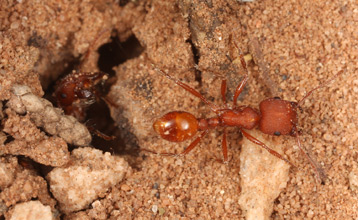- Identification
- Workers are separated from other congeners by the coarse interrugal spaces on their head, which are densely and strongly punctate, and the presence of an offset basal tooth on their mandibles. Mature colonies typically have a nest that is topped off by a large gravel covered mound that can be up to a meter wide and a half meter high.
- Biology
- Gregg (1963) has this to say about this species:
As is evident to anyone who explores the Sonoran Zone areas of western United States, Pogonomyrmex occidentalis is an exceedingly abundant and conspicuous ant. Its habits have been well known for many years, beginning with the celebrated investigations of the Rev. H. C. McCook, and probably no more characteristic ant (or even insect) can be found on the Western plains. Its conical nests are as diagnostic of the prairies as the prairie-dog burrows and as the bison. The nest entrance in the mounds is said to be located at the base and always on the east to southeast side, and I have checked this point many times and found that it holds true in practically every case, although some variations are noticeable.
- additional biology notes...
- Distribution
- Range
- United States: Arizona, North Dakota, South Dakota, Nebraska, Oklahoma, Texas, Montana, Wyoming, Colorado, New Mexico, Idaho, Utah, Nevada, California.
- Navajo Reservation Records
- Samples being processed.
- Additional Notes
- Pogonomyrmex are abundant and often conspicuous ants in arid low-latitude habitats of the Americas. Cole (1968) offered this well written general introduction to the genus:
The genus Pogonomyrmex is the preeminent group of harvesting ants in North America, where it nearly blankets the arid regions of Mexico and the western United States. As is true of other harvesting ants, the workers of this genus collect seeds for food, "harvesting" the plants in their nesting areas by snipping off the seeds with their mandibles. Husked within the nest and stored in subterranean or mound chambers, these highly nutritious seeds become the paramount food for the society, sustaining the ants even through the winter. Seeds are not their sole food, however, because the ants are scavengers as well as harvesters. Although their victims are chiefly arthropods, the workers may transport a varied array of dead booty to their nests.
The nests themselves are constructed in the soil, generally in areas fully exposed to the sun. Some are beneath stones, whereas others are surmounted by soil craters or by small to huge mounds with or without coverings of gravel. In addition, the workers of some species alter the area peripheral to the nests by clearing away the plants, felling them, bit by bit, with their powerful mandibles. Such mounds their surrounding denuded area, characteristic of the western harvester, are familiar sights to travelers in the arid West.
Although the workers of some species of Pogonomyrmex are extremely hostile and will vigorously attack and sting an invader, other species are contrastingly inoffensive and retiring.
- Pogonomyrmex occidentalis is one of the better studied ant species in North America. This is likely due to a number of factors that include: (i) The large size and persistence of their nest mounds. Some colonies are known to have existed for more than forty years. (ii) The abundance and wide-ranging distribution of the species. (iii) Their seed collecting abilities. (iv) The powerful sting of the workers, like many Pogonomyrmex, contains compounds that are painful to humans.
- In sum, this ant is one of the most noticeable and abundant ant species in many areas of the arid west. Its habits and its strong sting make it quite noticeable. As such it has attracted the attention of many myrmecologists that visit areas where this species is abundant.
- In sum, this ant is one of the most noticeable and abundant ant species in many areas of the arid west. Its habits and its strong sting make it quite noticeable. As such it has attracted the attention of many myrmecologists that visit areas where this species is abundant.
- Etymology
- Geographic. a reference to its range in western North America; L. occidentalis = western

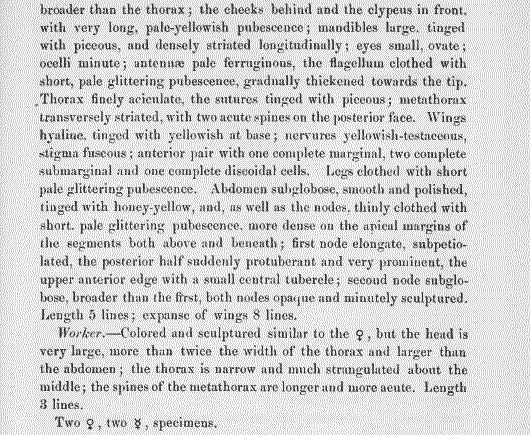
as reported by Cole (1968)
- Literature
- Cole, A. C., Jr. 1968. Pogonomyrmex harvester ants. A study of the genus in North America. University of Tennessee Press, Knoxville, Tenn.
- McCook, H. C. 1882. The honey ants of the Garden of the Gods, and the occident ants of the American plains. J. B. Lippincott & Co., Philadelphia.
- A note about these publications. The literature cited here is not meant to be an exhaustive list of papers published about this species.
Page authored by David Lubertazzi and Gary Alpert
